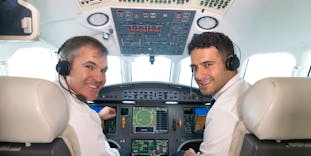Air Traffic Controller (ATC) Tests in 2025
Updated November 5, 2024
- What Is an Air Traffic Controller (ATC) Test
- What to Expect on an ATC Test
- Preparing for NATS ATC Tests
empty
empty
empty
empty
- Preparing for FAA ATC Tests
empty
empty
empty
empty
empty
empty
empty
- How to Prepare for an ATC Test in 2025
- Frequently Asked Questions
- Final Thoughts
It can take anywhere from two to four years to become a fully certified Air Traffic Controller (ATC).
This is not surprising, given the responsibilities of the role and the number of ATC tests you must pass.
After all, some 750,000 people travel through US airspace each day (outside of Covid-times) and therefore rely on ATCs to safely guide planes to their intended destination.
As such, Air Traffic Controllers are in constant wireless contact with pilots, offering advice on preparing for landing, ascent and weather conditions.
As an ATC, you will typically specialize either in approach controlling from an airport tower or airspace management from an area control center.
Most ATCs are employed by NATS in the UK or the Federal Aviation Administration (FAA) in the US.
To become an ATC with either organization is no mean feat.
One of the biggest challenges is mastering the ATC exams, including the ATC tests and air traffic controller practice test assessments.
What Is an Air Traffic Controller (ATC) Test
Training to become an air traffic controller is a long process. Employers need to know that the people applying for a traineeship are a suitable fit.
Therefore, ATC psychometric tests are used in the pre-qualification process.
ATC tests are essentially aptitude tests that evaluate your ability to become an Air Traffic Controller.
The purpose of taking ATC tests is to ascertain whether you can consistently manage air traffic by following air safety protocols.
In addition, these specialist psychometric tests are designed to measure your emotional and behavioral characteristics.
They are a very important part of the ATC job application process. Without passing the ATC tests, you will not advance to on-the-job training.
Take an Air Traffic Controller Prep
Furthermore, there is a limited timespan to consider too.
In the US, the FAA stipulates that you must apply for air traffic controller training before your 31st birthday.
The only exception to this is if you’re a former military ATC.
Therefore, if you are thinking of becoming an ATC, it is important to start preparing for the air traffic controller test sooner rather than later.
What to Expect on an ATC Test
Before going into detail on preparing for ATC tests, it is a good idea to know what will be expected of you.
For example, how much time will you need to dedicate to preparing for ATC exams, and what bearing will this have on the air traffic selection assessment?
Although training facilities will abide by the same air safety protocols, the air traffic controller test format may differ.
Therefore, before you start any preparation, you need to be clear on the training college you would like to join.
In this article, we cover the two main organizations already mentioned, NATS and the FAA.
Practice Air Traffic Controller Test with JobTestPrep
Preparing for NATS ATC Tests
NATS is, by far, the biggest employer of air traffic controllers in the UK.
It even has its air traffic selection assessment course at Fareham College in Hampshire.
Aspiring ATCs are paid to train and are guaranteed an ATC job after successfully passing the course.
However, they do not get the option of finalizing their specialty or where they work.
This is up to NATS, and to a certain degree, is influenced by ATC test results.
Since NATS makes such a big investment into each of its trainees, applicants are expected to pass the ATC tests with flying colors (excuse the pun!).
Take an Air Traffic Controller Prep
Understanding the Air Traffic Selection Assessment Process
The NATS air traffic controller test comprises three parts. If you fail any of the stages, you must wait 12 months before reapplying.
You cannot take a test more than three times.
On top of this, there can be a rather lengthy period between each air traffic selection assessment process.
This is good because it gives you enough time to refresh and prepare for the next step.
Stage 1 is the online application process, where, unlike the FAA, there is no upper age restriction.
You do, however, need to have at least five GCSEs at a Grade C and above (including Maths and English) and be over 18 years old.
In addition, NATS suggests that it is also advantageous if you have a technical or engineering degree since ATCs must have strong analytical mathematical and spatial awareness skills.
If you pass the online application process, you will receive an email inviting you to take the air traffic controller practice test.
These tests measure a series of cognitive abilities: brain-based skills that help you make reasoned, logical on-the-job decisions.
They use the ATC practice test to identify the very best people to train.
What do these cognitive psychometric tests involve?
Well, there are two steps:
Step 1 of the NATS ATC Test
Deductive Logical Thinking (Six Minute ATC Practice Test)
This is usually the first ATC test you will complete. You will be presented with a series of grids that contain various symbols (in squares).
There is a pattern to these symbols, and your job is to quickly identify the missing symbol in the square containing a question mark.
This may sound like a straightforward test; however, it is quite a challenge.
It requires you to analyze the symbols and use your deductive-logical cognitive skills to work out the answer.
Inductive Logical Thinking (Six Minute ATC Practice Test)
This test is notably different from the above logical reasoning ATC test.
You must find a related rule that two grids share rather than focusing on just one grid.
You must find the pattern and then locate two other grids (these look a bit like a sudoku set) that follow the same rule.
The idea behind these ATC tests is to see how well and quickly you can compare two data sets.
Spatial Orientation (Three Minute ATC Practice Test)
During this ATC test, you will be assessed on your ability to direct an aircraft based on your spatial awareness.
You will be asked to provide commentary on the position and flight path of a plane.
In addition, you will have to demonstrate how you would use both a gyrocompass and radio compass to land or guide a pilot successfully.
You will need to remain calm and reasoned under pressure, and so practice makes perfect for this ATC exam.
Monitoring Skills (Two Minute ATC Practice Test)
This psychometric test is much like some of the brain teaser games, yet on a heightened scale.
You will be presented with moving objects, which you will need to count and record the correct number displayed.
This is an important ATC test to pass since it conveys how good you will be at monitoring and controlling plane trajectories on screen.
Concentration Ability (Three Minute ATC Practice Test)
Often referred to as e3+ ATC exams, these ATC tests assess your ability to concentrate intensely.
You are shown a single yet busy image.
You must concentrate on the image for a short amount of time and take in as much as possible.
You are then asked a series of questions related to the contents of the image, which you must answer swiftly.
Depending on your qualifications, age, and experience, you may also be invited to a series of other ATC tests during Part 1.
These could be English proficiency tests for non-native UK residents tests to assess hand-eye coordination or short-term memory Air traffic controller tests.

Part 2 of the NATS ATC Test
Situational Judgment ATC Exams (Untimed ATC Test)
Having passed the first stage of the air traffic controller practice test, you will be presented with real-life ATC scenarios.
You will need to give a considered and detailed answer on the actions you would take.
There is no wrong answer as such. The test is simply assessing what your situational cognitive tendencies are and how they would impact real-life decisions.
Occupational Personality Assessment
This is the most extensive of the ATC tests. You will be presented with over 100 questions.
Each question contains three statements. You must choose two statements – one that is most like you and one that is least like you.
As one of the most comprehensive personality psychometric tests you are ever likely to have, this ATC test benchmarks you against over 30 known characteristics.
It measures your emotional intelligence as well as the way you think.
Preparing for FAA ATC Tests
As with the NATS ATC test, the FAA air traffic controller practice test is the first step in the ATC recruitment process.
Securing a place as a trainee at one of the FAA’s trainee colleges is tough since thousands of people apply every year.
Therefore, passing the ATC exams is not enough.
You must score highly to be successful and enjoy a career as an ATC with the FAA.
So, what is involved in the US ATC tests, and how are they structured?
Like the NATS tests, these ATC tests cover specific cognitive skills, and there are seven in total.
The FAA ATC test itself lasts three hours, and you must take them in one sitting.
Test 1: Memory ATC Test
Much like the NATS test, you are tested on what you see.
You will be presented with a series of numbers (one at a time), and you must quickly record the difference between the last two numbers when prompted at random.
This is a quick-fire ATC test that requires a great memory and huge concentration.
If you need to prepare for a number of different employment tests and want to outsmart the competition, choose a Premium Membership from JobTestPrep.
You will get access to three PrepPacks of your choice, from a database that covers all the major test providers and employers and tailored profession packs.
Test 2: Variables
This test contains three sets of 10 questions, each set getting progressively more difficult.
The first set reveals letters that equal a number (for example, S=11).
You will then see a series of letters where you must enter the correct numerical value.
The second and third sets are harder and involve a similar process, albeit with equations.
Test 3: Spatial Awareness ATC Tests
Much like the NATS spatial awareness test, you must quickly identify the aircraft's location to assess how far it is from another plane.
In the first part of the test, you must represent the larger of the two planes, and in the second part of the test, the view changes to line-of-sight as if you are judging the distance from the eye’s point of view.
You will have to select the correct reaction out of two possible answers.
Test 4: Collision Avoidance ATC Test
Delivered in two parts, you will need to show how you would be capable of stopping a collision based on your interpretation and management of aircraft on a screen.
First, balls will fly across the screen at random, and you will have to stop them from colliding.
In the second part, you must do the same while answering a math question at the same time.
Test 5: Logical Reasoning ATC Practice Test
Within this psychometric test, you must answer 15 questions in 20 minutes.
You will be asked to sort a group according to a set of rules.
For example, you may not be able to position certain people or objects together.
You must follow the rules carefully to make the most suitable seating arrangement.
This ATC test assesses your logical reasoning and ability to make decisions based on the information known to you.
Test 6: Personality Test
This is one of the ATC tests that intrigues people the most. You need not worry though.
If you want to be an ATC, you will already have many core skills for the role.
This personality test contains 108 questions (just four more than the NATS test) and again, gives you three statements to choose from.
You select the statement that most accurately describes you and the one that is least like you.
Test 7: Reading Comprehension ATC Test
This is the final part of the air traffic selection assessment tests. Given the amount of written information you will need to interpret, you must score highly in all 18 questions.
You have six paragraphs of text, and you must accurately answer three questions on each using multiple-choice answers.
This must be completed quickly and in no more than 15 minutes.
How to Prepare for an ATC Test in 2025
There is much you can do to prepare for the ATC tests.
As with any psychometric testing, practice makes perfect as you prepare your mind for the types of questions you will need to answer.
Step 1. Sit Past Papers/ATC Practice Exams
There are plenty of companies that offer ATC practice exams, using the same simulation software as the FAA and NATS.
Usually, these retail at around the $90 mark for three months’ worth of preparation.
For this cost, you will usually receive real-life examples of all ATC test parts or subsets.
Step 2. Study Materials and Books
You only need to type ‘ATC test’ into Amazon to reveal several different books by various authors entitled ATC practice tests.
The main publishers are Kaplan and TPB Publishing.
The books are reasonably priced at around $20.
Step 3. Create a Study Plan
It is a good idea to create a study schedule that works well for you.
For example, you will want to be undistracted to truly test your readiness if you take online practice ATC tests.
Therefore, you will want to find a quiet time – perhaps when everyone else is at work or school.
Within your study plan, you may wish to apportion more time to the tests you struggle with.
Add diary reminders if needs be.
Step 4. Learn the Question Formats
You will be more likely to succeed if you already know how the questions are presented.
That is why it is a good idea to seek for online ATC practise exams that provide you access to a variety of subsets of problems, rather than rehearsing the same questions repeatedly.
This is effectively known as test conditioning.
Step 5. Practice Against the Clock
Most air traffic controller practice tests will simulate the real-life test.
Therefore, once you are familiar with a specific ATC test, assess yourself against the allotted time.
This will give you an accurate indication as to whether you are ready.
After all, you can only take the test a certain amount of times.
Step 6. Know the Aviation Industry
Having a strong interest in the aviation industry and knowing what it is like to work as an ATC is hugely beneficial during the air traffic assessment process.
After all, you will be taking the ATC tests from the viewpoint of an air traffic controller.
If you think like one, you will increase your chances of behaving like one.
There are some fantastic aviation media outlets out there.
Check them out and speak to those who have already passed the air traffic controller test. They will no doubt have some handy tips.
Take an Air Traffic Controller Prep
There are seven different types of tests for which you can study.
They include:
- Memory ATC Test
- Variables
- Spatial Awareness ATC Test
- Collision Avoidance ATC Test
- Logical Reasoning ATC Practice Test
- Personality Test
- Reading Comprehension ATC Test
In the US you must have applied to become an ATC before your 31st birthday unless you have former military experience. You are also disqualified if you do not pass the ATC tests.
In the UK, many ATC tests are provided by National Air Traffic Services (NATS). The test comprises three parts and if you fail any part, you must wait 12 months before reapplying.
A test also cannot be taken more than three times. There can also be lengthy times between assessments, giving time to prepare but also taking longer to reach your goal.
Many companies offer practice tests including Practice Aptitude Tests, Assessment Centre HQ and JobTestPrep.
The psychometric tests measure emotional and behavioral characteristics. It also looks at logical thinking, spatial orientation, monitoring skills, concentration ability and situational judgment.
Applicants should make use of practice exams as well as study books that can be found for purchase online. Applicants can also make use of current air traffic controllers to ask them how they did on the tests, how they prepared and what advice they give.
Final Thoughts
The air traffic controller assessment process could appear complicated.
However, once you pass and are offered a traineeship, you are almost guaranteed a fantastic career.
Air traffic controllers who pass the ATC test and qualify usually earn around $91,000 a year.
Although it is a niche job role, there are numerous career opportunities.
You can choose to specialize as an approach and departure controller, a tower controller or an en-route controller, in either international or domestic airports.
If you have the right cognitive and problem-solving skills, it is a great career choice as you will constantly get to exercise these in demanding situations.
Remember to allocate a good three to four months of preparation time before taking the ATC tests, and you will have every chance of success!






